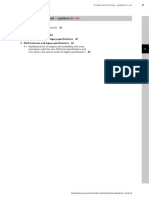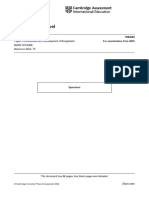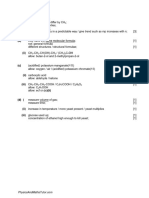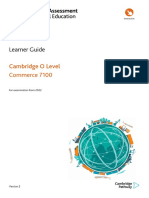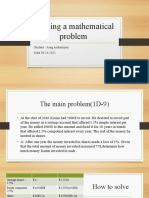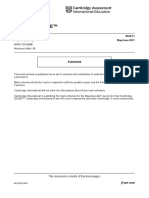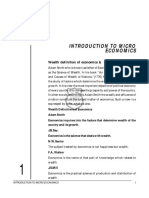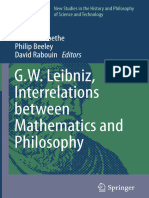Prescribed Title Number 5 May 2025
Uploaded by
BenPrescribed Title Number 5 May 2025
Uploaded by
BenPrescribed title 5: To what extent do you agree
with the claim “all models are wrong, but some
are useful”
(attributed to George Box)? Discuss with
reference to mathematics and one other area
of knowledge.
Theory of Knowledge
May 2025
To what extent do you agree with the claim “all models are wrong, but some are
useful”
(attributed to George Box)? Discuss with reference to mathematics and one other
area
of knowledge.
• To what extent: this asks you to evaluate the claim
• do you agree with the claim: this prescribed title asks you
specifically if you agree with the the claim in the prescribed
title. It is different from the other titles and you must
address this requirement that you state if you agree,
disagree or if you have a nuanced discussion of the claim
• “all models are wrong, but some are useful”: explain what
this means, namely it is about simplification, communication
• mathematics and one other area of knowledge:
mathematics must be addressed as it is explicitly identified
in the prescribed title; the other area of knowledge (AOK)
must be chosen by you: natural sciences, human sciences,
the arts or history.
What is a model?
A model is a representation, framework,
or conceptual tool used to explain,
describe, or predict phenomena within
an Area of Knowledge or discipline.
What the title asks you to
do is to consider:
a.All models
are wrong
b.Some
models are
useful
(utility of
knowledge)
c.Other
models may
not be useful
Features of utility of knowledge
Innovation and
Practical Decision Development Problem-
Application Making (Technology Solving
Development)
Predictive
Cultural and
Education and Power
Economic Value Social
Training (Modeling and
Understanding
Prediction)
Sustainability
Personal Health and
and Policy Making
Empowerment Well-being
Conservation
• https://www.youtube.com/watch?v=yQ
hTtdq_y9M&ab_channel=StatQuestwith
What is a JoshStarmer
mathematical
model?
• https://www.youtube.com/watch?v=h7k
qlYUV1l8&ab_channel=QuantaMagazin
Four Color Theorem e
(4CT) Kenneth Appel and
Wolfgang Haken in 1976
Similarities between theorems and models
1. Abstract Representation:
Both theorems and models are abstract representations or simplifications of reality. Theorems abstract mathematical truths into
statements that can be proven, while models abstract complex systems into manageable forms for analysis.
2. Foundation on Axioms or Assumptions:
Theorems are built upon axioms or previously proven theorems. Similarly, models are constructed based on certain assumptions about the
system they represent. These assumptions are akin to axioms in that they define the scope within which the model or theorem operates.
3. Predictive Power:
Theorems predict that under certain conditions, specific outcomes will always occur (if the premises are true). Likewise, models are used to
predict behavior or outcomes within the modeled system when certain conditions are met.
4. Logical Structure:
Theorems follow a logical structure where, from certain statements or premises, conclusions are drawn through deductive reasoning.
Models also often have an internal logic or set of rules that dictate how different components or variables interact.
5. Generalization:
Theorems offer generalizations that hold true across all instances where the initial conditions or premises are met. Models, too, aim to
generalize behavior or phenomena across a range of similar scenarios or datasets.
6. Verification and Validation:
Theorems must be proven, often through rigorous logical or mathematical proof. Models are validated by testing their predictions against
real-world data or experimental results. Both processes aim to confirm the reliability of the theorem or model.
7. Utility in Further Development:
A proven theorem can become a building block for further mathematical theories or proofs. Similarly, a validated model can be used as a
foundation for more complex models or for making decisions in policy, engineering, economics, etc.
8. Simplification for Understanding:
Both aim to simplify complex concepts or systems to make them understandable or manageable. Theorems reduce complex mathematical
relationships to concise statements, while models simplify real-world systems to key components or behaviors.
9. Iterative Refinement:
Just as theorems can lead to new insights or be refined with additional conditions or more general proofs, models are often refined or
updated as new data or understanding comes to light.
10.Interdisciplinary Application:
Theorems, especially in areas like geometry or logic, can have applications beyond pure mathematics, similar to how models developed in
one scientific field can find utility in others (e.g., statistical models in both physics and economics).
Types of Mathematical Models
• Deterministic Models: Assume that the system's behavior can be predicted exactly from the equations
and initial conditions without any random elements (e.g., Newton's laws of motion).
• Stochastic Models: Incorporate randomness or probability to reflect uncertainty or variability in the
system (e.g., stock prices, weather forecasting).
• Static Models: Don't account for time, focusing on equilibrium or balance (e.g., supply and demand
models in economics).
• Dynamic Models: Consider time as an integral component, capturing how systems evolve (e.g., predator-
prey models, epidemic spread models).
• Discrete Models: Deal with discrete entities or steps (e.g., individual-based models in ecology, queueing
theory for service systems).
• Continuous Models: Assume variables change smoothly over time or space (e.g., fluid dynamics, heat
transfer).
• Linear vs. Nonlinear Models: Linear models assume a linear relationship between variables, which
simplifies analysis but might not capture complex behaviors. Nonlinear models can describe more
complex dynamics but are often harder to solve.
• Spatial Models: Incorporate the geometry or spatial distribution of elements (e.g., diffusion in biology,
urban growth models).
• Network Models: Represent systems where connections between entities are key (e.g., social networks,
AOK Mathematics
• Possible Knowledge arguments
• The extent to which the model is deemed
wrong but useful is a function of its
construction and use.
• Mathematical models' primary use is when
they are applied with knowledge from
other AoKs (rather than used solely within
Maths), regardless of the degree of their
“wrongness”.
Natural Scienceshttps://climateextremes.org.au/what-is-a-climate-
model/
https://www.nature.com/scitable/
knowledge/library/studying-and-
projecting-climate-change-with-earth-
103087065/
AOK Human Sciences and discipline
anthropology
• Possible Knowledge arguments
1. The extent to which the model is deemed wrong
but useful is a function of its construction and use.
2. Anthropological models' primary use is when they
are applied considering a static view of culture:
traditional models sometimes treat cultures as static
entities. However, cultures are dynamic and constantly
evolving, influenced by internal changes and external
interactions. Therefore, they were applied regardless of
their “wrongness” degree.
Other known knowledge issues with
anthropology
• Ethnocentrism: There's a risk that anthropologists might view other cultures through the lens of their own cultural norms and
values, potentially misinterpreting or devaluing practices that differ from their own.
• Overgeneralization: Models often seek to find universal principles or patterns, which can lead to overgeneralization. This might
ignore the unique aspects of individual cultures or subcultures, leading to stereotypes rather than nuanced understanding.
• Cultural Evolutionism: Some traditional anthropological models suggest a linear progression of societies from 'primitive' to
'advanced', which is now widely criticized for being both ethnocentric and simplistic. Modern anthropology recognizes that cultural
change doesn't follow a single path.
• Observer Bias: The presence of an anthropologist can influence the behavior of the people being studied (the observer effect),
which might lead to inaccurate data. Moreover, the interpretation of observations can be biased based on the anthropologist's
background.
• Static View of Culture: Traditional models sometimes treat cultures as static entities. In reality, cultures are dynamic and
constantly evolving, influenced by internal changes and external interactions.
• Reactivity: People might change their behavior when they know they are being studied, which can skew research findings.
• Representation and Voice: There's a critique about who gets to represent whom. Often, anthropological studies have been
conducted by Western researchers on non-Western societies, raising questions about power dynamics, representation, and whose
voice is actually being heard in ethnographic accounts.
• Applicability: Models developed in one cultural context might not apply well to another, which challenges the universal applicability
of some anthropological theories.
• Complexity of Human Societies: Human behavior and societal structures are incredibly complex. Models might simplify this
complexity for the sake of understanding, but in doing so, they can miss out on the intricacies that define human interactions.
• Historical Context: Many anthropological models were developed during colonial times, carrying implicit biases or explicit aims
related to colonialism, which can affect their objectivity and relevance in post-colonial analysis.
• Interdisciplinary Challenges: Anthropology often intersects with other disciplines like sociology, psychology, economics, etc.
Bibliography for knowledge issues in anthropology
• Ethnocentrism:
• Boas, F. (1940). "Race, Language, and Culture." Macmillan. Boas is often credited with the development of cultural relativism, a principle meant to combat ethnocentrism in
anthropology.
• Overgeneralization and Cultural Evolutionism:
• Steward, J.H. (1955). "Theory of Culture Change: The Methodology of Multilinear Evolution." University of Illinois Press. While this work itself promotes a form of cultural evolution,
it has been critiqued for its linear approach.
• Sahlins, M., & Service, E. R. (Eds.). (1960). "Evolution and Culture." University of Michigan Press. This discusses issues with cultural evolutionism.
• Observer Bias:
• Clifford, J., & Marcus, G.E. (Eds.). (1986). "Writing Culture: The Poetics and Politics of Ethnography." University of California Press. This collection addresses how ethnographies are
constructed and the biases inherent in observation and writing.
• Reactivity:
• Heider, K.G. (1988). "The Rashomon Effect: When Ethnographers Disagree." American Anthropologist, 90(1), 73-81. While not directly about reactivity, it discusses differing
interpretations which can be influenced by observer presence.
• Static View of Culture:
• Appadurai, A. (1996). "Modernity at Large: Cultural Dimensions of Globalization." University of Minnesota Press. Appadurai discusses the fluidity and dynamism of culture in the
context of globalization.
• Representation and Voice:
• Said, E. W. (1978). "Orientalism." Pantheon Books. Although not solely an anthropological work, it critically examines the representation of the "East" by the "West," which has
implications for anthropology.
• Complexity of Human Societies:
• Geertz, C. (1973). "The Interpretation of Cultures." Basic Books. Geertz's advocacy for "thick description" emphasizes the complexity of cultural interpretation.
• Historical Context and Colonialism:
• Asad, T. (Ed.). (1973). "Anthropology & the Colonial Encounter." Humanity Books. This work examines anthropology's relationship with colonialism.
• Interdisciplinary Challenges:
• Bourdieu, P. (1977). "Outline of a Theory of Practice." Cambridge University Press. While Bourdieu is a sociologist, his work on practice theory has influenced anthropological thought,
illustrating interdisciplinary challenges.
Kinship Systems Model
• The model is based on the Iroquois kinship system, where certain relatives are
classified differently than in Western systems.
• Knowledge issues: The model simplifies real-life relationships into rigid categories. For
instance, it might not account for adopted kin, blended families, or changing gender roles
that can alter kinship ties in modern contexts.
• Usefulness: It provides a framework for understanding how different societies organize
family and social responsibilities. This model helps anthropologists explore social
organization, inheritance, and marital alliances across cultures, revealing much about social
structure even if it doesn't capture every nuance.
• Reading:
• Schneider, D. M. (1984). A Critique of the Study of Kinship. University of Michigan
Press.
• Schneider critiques earlier models of kinship, providing a basis for understanding how
kinship models might oversimplify complex social realities.
• Carsten, J. (2004). After Kinship. Cambridge University Press.
• Carsten discusses how kinship studies have evolved, addressing contemporary issues like
adoption and new reproductive technologies, highlighting the limitations of traditional
models.
Clifford Geertz's Interpretive
Anthropology Model
• Model Description: Geertz proposed that culture should be understood
through "thick description," an ethnographic method that explains not
just behaviors but their contexts so that they become meaningful to an
outsider.
• Knowledge issues: This approach might be biased by the
anthropologist's interpretation, potentially missing or
misrepresenting the layers of meaning that can be understood
differently even within the culture itself.
• Usefulness:
• Despite the potential for subjective bias, Geertz's model has been
incredibly influential in shifting anthropology towards meaning-
centered analysis. It's useful for capturing the depth of cultural
practices, like his famous analysis of the Balinese cockfight,
providing insights into symbolic meanings within cultural acts.
• Reading:
• Geertz, C. (1973). The Interpretation of Cultures. Basic Books.
This book includes his essay on "Thick Description," outlining his
approach to ethnography and culture.
Cultural Materialism Model
• Model Description: Proposed by Marvin Harris, this model suggests that the
material conditions (like technology, environment, and economy) determine social
structure and ideology.
• Knowledge issues: Critics argue it's overly deterministic, reducing complex
cultural phenomena to mere economic or environmental factors, often
overlooking the agency of individuals or the influence of ideas.
• Usefulness: It provides a powerful lens for examining how environmental
and economic factors influence cultural practices and societal organization.
For instance, Harris's analysis of the sacred cow in India shows how
materialist explanations can reveal practical reasons (like the use of cows for
milk, fuel, and labor) behind seemingly purely religious or cultural practices.
• Reading:
• Harris, M. (1979). Cultural Materialism: The Struggle for a Science of
Culture. Random House.
• Harris's key work where he outlines the principles of cultural
materialism.
• Kuznar, L., & Sanderson, S.K. (2007). Studying Societies and Cultures:
Marvin Harris's Cultural Materialism and Its Legacy. Paradigm Publishers.
• A compilation that discusses the impact and critiques of Harris's
work.
The Model of Hunter-Gatherer
Societies:
• These early anthropological models often depicted hunter-
gatherer societies as simple, egalitarian, and living in harmony
with nature, as seen in studies like those of the Kung San people.
• Knowledge Issues: More recent research shows that these societies can
be more complex, with varying hierarchy levels, conflict, and
environmental impact than previously thought. The model oversimplifies
the diversity among such groups.
• Usefulness: This model has been instrumental in challenging the notion
that human history is a straightforward progression from "simple" to
"complex" societies. It helps in understanding human adaptability, the
origins of inequality, and the impact of the environment on lifestyle.
https://www.scientificam
erican.com/article/the-th
eory-that-men-evolved-t
o-hunt-and-women-evol
ved-to-gather-is-wrong1/
Geography models - 1
• Von Thünen’s Model of Agricultural Land Use:
• Usefulness: Explaining how the location of agricultural activities is influenced by the cost of transportation to market and the land
rent.
• Knowledge issues: It assumes a uniform plain with a single market center, no differences in soil fertility, and rational economic
behavior, which oversimplifies real-world conditions.
• Reference: Chisholm, M. (1962). Rural Settlement and Land Use. Not exclusively about von Thünen, but it discusses his model in
detail in the context of land use patterns.
• Central Place Theory (by Walter Christaller):
• Useful for: Understanding the distribution, size, and number of settlements in a region.
• Wrong because: It assumes an isotropic plane, even distribution of population and purchasing power, and that people will always go
to the nearest center for goods, ignoring cultural preferences or modern transportation networks.
• Reference: King, L.J. (1984). Central Place Theory. A book that discusses the theory in detail, its implications, and applications.
• Gravity Model of Migration:
• Usefulness: Predicting the degree of interaction between two places based on their populations and the distance between them.
• Knowledge issues: It doesn't account for many real-world factors like political barriers, cultural differences, or personal preferences in
migration decisions.
• Reference: Isard, W. (1956). Location and Space-Economy. Here, Isard applies concepts like the gravity model to economic geography.
• The Demographic Transition Model (DTM):
• Useful for: Describing the transition from high birth and death rates to low birth and death rates as a country develops from a pre-
industrial to an industrialized economic system.
• Knowledge issues : It doesn't fit all countries uniformly; some countries skip stages or move through them at different rates due to
unique cultural, political, or economic factors.
• Reference: Kirk, D. (1996). "Demographic Transition Theory." Population Studies, 50(3), 361-387. Kirk provides a historical overview
and critique of the model, discussing its evolution and relevance.
Geography models - 2
• Urban Models like Burgess’s Concentric Zone Model:
• Usefulness in science: Understanding the internal structure of cities where different zones of land use radiate out from a central business district.
• Knowledge issues: Modern cities often have multiple nuclei, polycentric structures, and the model doesn't account for urban sprawl, gentrification, or the impact of
modern transport and planning.
• Reference: Carter, H. (1995). The Study of Urban Geography (4th ed.). London: Arnold. Carter's book is a staple in urban geography, providing an in-
depth look at urban land use models including a critical analysis of the concentric zone model.
• Weber's Model of Industrial Location:
• Usefulness in science: Determining the optimal location for industries based on the cost of transportation, labor, and agglomeration benefits.
• Knowledge issues: It simplifies factors like government policy, environmental considerations, or modern logistics, which can significantly alter industrial location decisions.
• Reference:Isard, W. (1956). Location and Space-Economy: A General Theory Relating to Industrial Location, Market Areas, Land Use, Trade, and Urban
Structure. MIT Press. Isard's work expands on Weber's ideas, integrating them into a broader theory of location and space economy.
• The Rank-Size Rule:
• Usefulness: Analyzing the distribution of city sizes in a country or region where the nth largest city is 1/n the size of the largest city. The Rank-Size Rule is an empirical
regularity observed in the distribution of city sizes within many countries or regions. Here's a detailed explanation:
The Rank-Size Rule suggests that the population of a city or town in an ordered list (ranked by population size) can be approximated by a simple mathematical relationship:
Knowledge issues: Not all urban systems follow this rule due to primate cities where one city is disproportionately larger than others, or due to historical or political
reasons. Real-World Example: The U.S. has approximated the rank-size rule relatively well for its larger cities, though with some deviations, especially when
considering all urban areas. India shows significant deviation with several very large cities and then a sharp drop-off, not closely adhering to the rule. Brazil has a
distribution that might fit the rule for mid-tier cities, but São Paulo and Rio de Janeiro are outliers due to their primacy.
• References: Zipf, G.K. (1949). Human Behavior and the Principle of Least Effort. Addison-Wesley Press. Although Zipf's work is broader and
encompasses the principle of least effort applied across various phenomena, his observations on city sizes are foundational to what we now refer to
as the Rank-Size Rule.
• Berry, B.J.L., & Garrison, W.L. (1958). "Alternate Explanations of Urban Rank-Size Relationships." Annals of the Association of American Geographers,
48(1), 83-90. This paper discusses the rank-size rule in the context of urban geography, exploring its implications and validity.
• Mathematical models to explain the origin of urban scaling laws Fabiano L. Ribeiroa,∗,1, Diego Rybsk
You might also like
- Immediate Download Oxford IB Business Management - Course Companion Loykie Lominé Ebooks 202460% (5)Immediate Download Oxford IB Business Management - Course Companion Loykie Lominé Ebooks 202457 pages
- (Daniel I. A. Cohen) Introduction To Computer Theo (BookSee - Org) 2No ratings yet(Daniel I. A. Cohen) Introduction To Computer Theo (BookSee - Org) 2649 pages
- Revision Guide Business Studies IGCSE 0450 2024No ratings yetRevision Guide Business Studies IGCSE 0450 202457 pages
- G Steiner 10 Reasons For Sadness of ThoughtNo ratings yetG Steiner 10 Reasons For Sadness of Thought31 pages
- Exam Practice Question Glori Fried Chicken Rima Puri v2 WZ AnswersNo ratings yetExam Practice Question Glori Fried Chicken Rima Puri v2 WZ Answers4 pages
- 1st Year 2nd Year 3rd Year: Diagram of The Undergraduate Programme in EconomicsNo ratings yet1st Year 2nd Year 3rd Year: Diagram of The Undergraduate Programme in Economics1 page
- Benedict M. Ashley - The Arts of Learning and Communication PDF100% (1)Benedict M. Ashley - The Arts of Learning and Communication PDF433 pages
- ICMI Study 19 Vol 2, Proceedings: Proof and Proving in Math Education0% (1)ICMI Study 19 Vol 2, Proceedings: Proof and Proving in Math Education300 pages
- Antigua and Barbuda - Paper 1 IB LangLit SLNo ratings yetAntigua and Barbuda - Paper 1 IB LangLit SL3 pages
- (MAI 3.6-3.7) TRIGONOMETRIC CIRCLE - RADIANS - TRIANGLES II - Solutions100% (1)(MAI 3.6-3.7) TRIGONOMETRIC CIRCLE - RADIANS - TRIANGLES II - Solutions7 pages
- PHIL 210 - Critical Thinking Winter 2024No ratings yetPHIL 210 - Critical Thinking Winter 202415 pages
- Edexcel IGCSE 9-1 EAM Marking Scheme For Paper 1No ratings yetEdexcel IGCSE 9-1 EAM Marking Scheme For Paper 117 pages
- Cambridge IGCSE English Second LanguageNo ratings yetCambridge IGCSE English Second Language153 pages
- Business Studies Notes For IGCSE - Chapter 12 - Communication in BusinessNo ratings yetBusiness Studies Notes For IGCSE - Chapter 12 - Communication in Business14 pages
- 6.1basic Economic Problem Choice and The Allocation of Resources100% (1)6.1basic Economic Problem Choice and The Allocation of Resources3 pages
- IB Extended Essay Subject Specific Guide Excerpt100% (1)IB Extended Essay Subject Specific Guide Excerpt265 pages
- Mark Scheme (Results) January 2023: Pearson Edexcel International GCSE Biology (4BI1) Paper 1BNo ratings yetMark Scheme (Results) January 2023: Pearson Edexcel International GCSE Biology (4BI1) Paper 1B25 pages
- Cambridge IGCSE Business Studies 4th EditionNo ratings yetCambridge IGCSE Business Studies 4th Edition366 pages
- Ib Business Management - 3.5a Activity - Profitability and Liquidity Ratio AnalysisNo ratings yetIb Business Management - 3.5a Activity - Profitability and Liquidity Ratio Analysis2 pages
- IBDP B-Man Compiled Class Notes 2024 SyllabusNo ratings yetIBDP B-Man Compiled Class Notes 2024 Syllabus60 pages
- 7100 Learner Guide (For Examination From 2022)No ratings yet7100 Learner Guide (For Examination From 2022)28 pages
- Solving A Mathematical Problem: Student - Areg Arshamyan Date 09.16.2021No ratings yetSolving A Mathematical Problem: Student - Areg Arshamyan Date 09.16.20217 pages
- IGCSE-OL - Bus - Sec - 2 - Answers To Case Study - Enhanced - 2ANo ratings yetIGCSE-OL - Bus - Sec - 2 - Answers To Case Study - Enhanced - 2A4 pages
- Cambridge IGCSE™: French 0520/11 May/June 2021No ratings yetCambridge IGCSE™: French 0520/11 May/June 20213 pages
- Advantages of Multiculturalism in The Workplace 6244020% (5)Advantages of Multiculturalism in The Workplace 624402 pages
- Get AQA A level Economics Book 2 Ray Powell; James Powell free all chaptersNo ratings yetGet AQA A level Economics Book 2 Ray Powell; James Powell free all chapters14 pages
- The Edupreneur: Your Blueprint To Jumpstart And Scale Your Education BusinessFrom EverandThe Edupreneur: Your Blueprint To Jumpstart And Scale Your Education BusinessNo ratings yet
- Comprehensive Guide to LaTeX: Advanced Techniques and Best PracticesFrom EverandComprehensive Guide to LaTeX: Advanced Techniques and Best PracticesNo ratings yet
- Practice_Questions_for_Minor_2_-_Paper_2_-_AAHL_-_DP2_-_09.12.24 (1)No ratings yetPractice_Questions_for_Minor_2_-_Paper_2_-_AAHL_-_DP2_-_09.12.24 (1)73 pages
- 2024 May Geog SLHL TZA Paper 2 Resource BookletNo ratings yet2024 May Geog SLHL TZA Paper 2 Resource Booklet5 pages
- Change Principles of Problem Formation and Problem ResolutionNo ratings yetChange Principles of Problem Formation and Problem Resolution216 pages
- An Outspread On Valued Logic SuperhyperalgebrasNo ratings yetAn Outspread On Valued Logic Superhyperalgebras11 pages
- The Rural-Urban Continuum A Critical EvaluationNo ratings yetThe Rural-Urban Continuum A Critical Evaluation14 pages
- Lesson 1: Historical and Philosophical Perspective of The Nursing ProfessionsNo ratings yetLesson 1: Historical and Philosophical Perspective of The Nursing Professions8 pages
- (Springer) (Archimedes 41) G.W.Leibniz, Interrelations Between Mathematics and Philosophy (New Studies in The History and Philosophy of Science and Technology)No ratings yet(Springer) (Archimedes 41) G.W.Leibniz, Interrelations Between Mathematics and Philosophy (New Studies in The History and Philosophy of Science and Technology)215 pages
- Does Mathematics Need New Axioms?: Solomon FefermanNo ratings yetDoes Mathematics Need New Axioms?: Solomon Feferman19 pages
- Mathematics: Quarter III-Week 1 Learning Activity Sheets (LAS)No ratings yetMathematics: Quarter III-Week 1 Learning Activity Sheets (LAS)8 pages
- Get Subsystems of Second Order Arithmetic 2nd Edition Stephen G. Simpson PDF ebook with Full Chapters Now100% (10)Get Subsystems of Second Order Arithmetic 2nd Edition Stephen G. Simpson PDF ebook with Full Chapters Now60 pages
- A Very Good Read On The Construction of Natural NumbersNo ratings yetA Very Good Read On The Construction of Natural Numbers5 pages
- Problem Solving Using Geogebra - The Case of Geometry: Kaja MaricicNo ratings yetProblem Solving Using Geogebra - The Case of Geometry: Kaja Maricic10 pages
- Get A Gateway to Modern Geometry The Poincare Half Plane 2nd Edition Saul Stahl PDF ebook with Full Chapters Now100% (5)Get A Gateway to Modern Geometry The Poincare Half Plane 2nd Edition Saul Stahl PDF ebook with Full Chapters Now81 pages
- First Principles Thinking Manual by FIPSNo ratings yetFirst Principles Thinking Manual by FIPS60 pages
- Geometry and Its Applications 3rd Edition Walter J. Meyer - The ebook in PDF format is ready for immediate accessNo ratings yetGeometry and Its Applications 3rd Edition Walter J. Meyer - The ebook in PDF format is ready for immediate access71 pages
- Formative Assessment 8 - Geometry&stat PDFNo ratings yetFormative Assessment 8 - Geometry&stat PDF2 pages
- The Inconsistency in G Odel's Ontological Argument: A Success Story For AI in MetaphysicsNo ratings yetThe Inconsistency in G Odel's Ontological Argument: A Success Story For AI in Metaphysics7 pages
- A Concise History of Mathematics for Philosophers -- John Stillwell -- 2019 -- Cambridge University Press -- 9781108456234 -- 369f510dbc4d5e078419d1926eb95e06 -- Anna’s ArchiveNo ratings yetA Concise History of Mathematics for Philosophers -- John Stillwell -- 2019 -- Cambridge University Press -- 9781108456234 -- 369f510dbc4d5e078419d1926eb95e06 -- Anna’s Archive78 pages
























